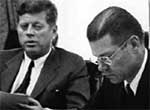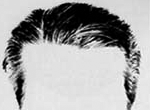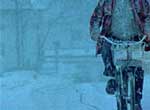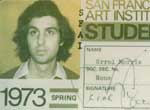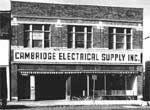MODERATOR: Good morning. Hi. It’s a great audience. It looks that way from here. Welcome to the 17th Annual Chicago Humanities Festival. We hope you’ve seen many of the events so far. And there’s plenty of excellent events yet to come. So we encourage you to see as many as possible.
First, I’d like to thank the Washington Library for their generosity, allowing us to use this facility for this exceptional program. And this morning we are extremely fortunate to have with us one of the finest and most important filmmakers working today, Errol Morris. His films have won just about every single major filmmaking award possible on the earth today. Most recently, The Academy Awards, for his film The Fog of War.
If Errol were to stop making films today, his body of work would constitute some of the most creative, provocative, entertaining documentaries ever made. In fact, Roger Ebert, who is quite familiar to our Chicago community, has called Errol’s first film, Gates of Heaven, one of the top ten greatest films of all times. His art has elucidated topics as complex as the Big Bang, as emotional as murder, and as wonderfully nuanced as human eccentricity.
So with that very, very brief introduction, it is my distinct pleasure to introduce Errol Morris. [applause]
ERROL MORRIS: Thank you, and thanks to the Chicago Humanities Festival for bringing me here today. Obviously, I owe a lot to Chicago, Roger Ebert in particular, for having been a friend to me and to my filmmaking for as long as I’ve been making films.
There’s a whole issue of what really to talk about here today. I’m in that strange area, grey area between films. I am trying to finish another film for Cannes next year. One of the things I thought I could talk about – and if this is of no interest, please stop me at once. [laughter]
Over the years I’ve been asked, “Where do these projects come from? Why did you make this film or that film? How did you become first interested in a project?” And I thought I would talk about some of my past films, and this current project, because it’s very much on my mind. Certainly the origins of the project are very much on my mind as well.
I’ve gone back and forth, maybe some kind of crazy seesaw between films that are politically concerned, and films that are just plain whacked out. It would be very difficult to make a case for why Gates of Heaven, my pet cemetery movie, or Vernon, Florida, or Fast, Cheap and Out of Control were activist films. They may be activist films, but I’m not sure activist for what? On the other hand, The Thin Blue Line, Mr. Death, and The Fog of War have political concerns. It would be very difficult for me to argue otherwise.
And the current film that I’m working is about Abu Ghraib – more specifically, the infamous photographs of Abu Ghraib. I’m surprised myself that I’m doing this. It doesn’t seem to me to be the kind of thing that I would try to do, but there are a number of things that have influenced the decision. One of which I would describe as the feeling that the world is going to hell. That may have been temporarily postponed by last Tuesday’s elections. [laughter] But, maybe the result is still inevitable. These things that give you false hope are very, very disturbing.
A friend of mine who spoke here last week, Philip Gourevitch, said that after the elections he felt this huge weight lifted off of his shoulders. And he realized for the first time how badly he had felt for the last six years, a sentiment which I share.
So first I had the feeling that I had to do something with political content this time around. Also, I’m attracted to mysteries. And by mysteries I mean things I don’t understand, things that puzzle me, confuse me. The Thin Blue Line came out of just that kind of situation. I had been out of work. I had not been able to raise any money, or to convince anybody to give me any money to make another film. And that persisted for six or seven years. My 30’s were not what I would call the best period of my career. I worked as a private detective in order to earn a living in New York City. [laughter] It’s really not that funny, particularly if you knew the details of what I was doing.
Finally, I had been given money to make a movie that I had no desire to make. I had submitted a proposal to Public Broadcasting thinking that it was the kind of thing they might give me money for rather than the kind of thing that interested me. You might call it, a calculation. (PBS prefers bad sociology disguised as television or perhaps it’s the other way around.) So I was given money to make a film about a Dallas psychiatrist with this friendly nickname, “Dr. Death”. And he was given the nickname because of the role he played in Texas-style capital punishment. In order to sentence a man to death in Texas you have to make a prediction about their future behavior. Not enough to say they’ve been bad in the past, you have to say they’re going to be bad in the future.
And I would point out that you don’t believe that you can predict human behavior, except in one instance, what Dr. Grigson, Dr. Death, will say in the penalty phase of a capital murder trial – that could be predicted with some accuracy. And so I became involved in this crazy story, where I stumbled upon one death row inmate. I had interviewed some 20 people who had been sentenced to death, in part because of Dr. Death’s testimony.
I met this one man, Randall Dale Adams at Eastham Unit, a prison in central Texas. He told me the story that you expect to hear – namely, I didn’t do it. I didn’t believe him or disbelieve him. Not at first, but his story grew on me slowly but surely. And I became caught up in the mystery of what actually had happened. Here’s a man who had been sentenced to death. And as I began to read about the details of the crime, and as I began to talk to people – many who had been witnesses at his trial – I slowly became convinced that he was innocent.
I believe that The Thin Blue Line is the only movie that actually investigates a murder; it’s not a movie about a murder investigation. I’m actually investigating a murder with a camera. I’m putting people in front of the camera and interviewing them. And as it turns out, a filmed interview is a powerful investigative tool, particularly when it’s not adversarial. I often draw a distinction between say a Mike Wallace style interview and what I do.
The idea is not to incriminate, to impugn or to challenge, but to elicit. And in the course of doing these interview I uncovered new evidence. Surprise. All the major witnesses had committed perjury. Well, they admitted to perjury on camera. Often they didn’t even know that they were admitting to perjury. They had forgotten what their testimony had been during the trial and had unwittingly “reverted” to their memories of what had happened. Let me tell you a story.
Emily Miller, the wacko platinum blonde witness in The Thin Blue Line, is probably my favorite of all the characters I have put on film. She and her husband had driven by the crime scene, and she claimed that she had seen the shooting of the Dallas police officer. Her claim was buttressed by her testimony at trial that she had picked the defendant out of a police lineup.
I had terrible difficulty tracking her down, but I finally found her and arranged an interview. She told me a number of surprising things. Among them, that she had failed to pick out Adams in a police lineup. In fact, she started making excuses for herself and for her failure to identify the defendant. She was spooked that day. The lighting was strange. Adams had changed his hair-style. He was looking at her “funny” and on and so forth. But she was unequivocal about one thing. She had not picked him out in the lineup. Later, I asked her. “Emily, you say, you didn’t pick Adams out in the lineup. How do you know you didn’t pick him out?” She became somewhat annoyed with me – my audacity at challenging her claim that she hadn’t picked him out. She said, “I know.” And I said, “But how do you know?” And she said, “I know because the policeman sitting next to me told me I had picked out the wrong person, and then pointed out the right person so I would never make that mistake again.
Now, I’m told that I made a movie that got an innocent man out of prison. But it’s not the movie that got an innocent man out of prison, it was the interviews and the investigation – part of which was done with interviews. The investigation – not the “movie” - did it. The movie was the container for an investigation, for an inquiry. I should mention, it’s also a movie in which the real killer confesses to the crime. And he confesses to the crime in an interview.
Looking back on the films I’ve made, I realize that nothing has been planned. My life has been a mess. And this Abu Ghraib thing is a really good example of a complete lack of planning. But investigations can never really be planned because you never know what you’re going to uncover. You never know what you’re going to learn.
I’ve always been fascinated by iconic photographs, of how and why a photograph becomes iconic, particularly a war photograph. And what we can actually learn from photographs. We have these now infamous photographs from Abu Ghraib. I don’t know how many are available to the public. I know I’ve seen thousands of them at this point.
There are three that stand out from all the others – the most famous among them: (1) Lynndie England holding Gus – his name was given to him by the MPs –on a leash; (2) the human pyramid; and (3) the detainee that they called Gilligan, standing on a box, hooded with wires. All three of those photographs have become extraordinarily well known around the world.
Here’s my hunch. A hundred years, two hundred years from now when people look back on this period in world history, and they look back on the Iraq War, which we are still very much in the middle of, the iconic photographs of that war will be the photographs that I’ve just mentioned. I don’t know it for sure, I could be wrong, but it is my guess that those will be “the” photographs that are remembered of the war. And the question then becomes – among a myriad of questions – why? Why these photographs?
What are these photographs really about, what do they mean? Now, I have to ask your indulgence, whether you’re interested in pursuing this with me at the moment. I hear just complete silence out there. [applause]
I have never, ever done a PowerPoint presentation. I actually have never been to a PowerPoint presentation. These are the two things, by the way, that I’m extremely proud of. Notwithstanding, I actually brought a PowerPoint presentation with me today to give you an idea of what I’m doing.
There was an article that appeared in The New York Times Magazine written by Susan Sontag about the Abu Ghraib photographs. She was one of the very few people – I guess here’s another Chicago connection – to mention that one of the oddities of these photographs is that they were posed. People posed the pictures. They posed in the pictures, and they posed people for the pictures. They were involved in some kind of performance for the camera.
And they’re the first iconic war photographs that weren’t taking by a war photographer. It’s not Joe Rosenthal taking a picture of the flag-raising on Mt. Suribachi. It’s MP’s taking pictures of themselves in this age of digital cameras. Parenthetically, I should mention I’m doing this movie for Sony. I had this, I thought, great idea of inverse product placement. All the cameras that were used were Sony cameras. And I asked one executive, “How much would you pay me not to mention that fact, [laughter], or to include any Sony cameras in the movie?” I think it’s a really good idea.
So, the Susan Sontag article interested me and puzzled me for many reasons. And then she came out with this book. Now, here is a true test of my mettle. Let’s see if I can pull off a PowerPoiont presentation to this audience. I have a clicker, I can do this myself.
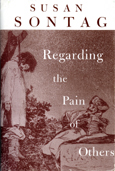 Here is the cover of Susan Sontag’s last book before she died, Regarding The Pain Of Others. The book irritated me for a number of reasons. And this despite the fact that I admire Susan Sontag enormously. One of the things I deeply regret is that she is not around to have a conversation about all of this material. My incredible loss. But, she mentions in the book a pair of photographs, captioned “The Valley of the Shadow of Death,” that were taken by Roger Fenton in 1855, actually April 23rd, 1855. And she says that one of the photographs was posed. And I started to wonder, when we even talk about posing a photograph, what are we talking about?
Here is the cover of Susan Sontag’s last book before she died, Regarding The Pain Of Others. The book irritated me for a number of reasons. And this despite the fact that I admire Susan Sontag enormously. One of the things I deeply regret is that she is not around to have a conversation about all of this material. My incredible loss. But, she mentions in the book a pair of photographs, captioned “The Valley of the Shadow of Death,” that were taken by Roger Fenton in 1855, actually April 23rd, 1855. And she says that one of the photographs was posed. And I started to wonder, when we even talk about posing a photograph, what are we talking about?
We talk about the Abu Ghraib photographs being posed. Well, there’s a claim about almost every single iconic war photograph ever taken, namely, that it was posed. This includes the photograph by Joe Rosenthal of the flag raising on Iwo Jima, the very famous Robert Capa photograph of the fallen republican soldier, the Alexander Gardner photograph of the rebel sharpshooter at Gettysburg and on and on and on. There’s a long laundry list of these claims.
And I wondered what are they really talking about? Can we look at a photograph learn and figure out whether it was posed? What content do photographs have? So let me try this again. We’ll go quickly through it.
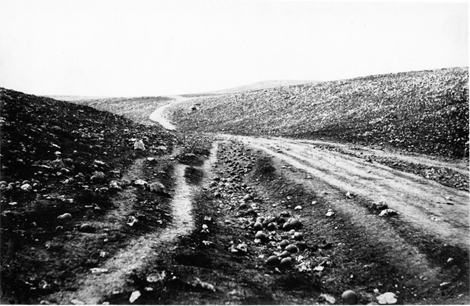
This is the photograph, or one of the pair of photographs, “The Valley of the Shadow of Death.” By the way, Sontag suggests that Fenton had given it this name to make the viewer think that it was the scene of the charge of the Light Brigade. (Tennyson, after all, wrote about “the valley of death.”) I don’t know what Fenton was thinking, but it seems unlikely this is what he had in mind. I found on maps of the period a Valley of the Shadow of Death, and it was named by British soldiers because it was situated within the range of three separate Russian batteries – the Barracks Battery, the Garden Battery and the Great Redan. You see it on many maps and in soldier and newspaper accounts.
But, here, maybe I can trap you into getting interested in the same way that I became interested in this craziness. Here’s the picture. Interesting, I would add, there’s nobody in it. And one of the things that characterized the Crimean War-- The Crimean War, for me, is the perfect war. No one knows really why it was started. No one really knows when it ended. It accomplished absolutely nothing, save for one very important and salient fact – it destroyed hundreds of thousands of lives. It seems, in essence, to be the perfect exemplar of human murderous futility. Themes, by the way, that I just adore.
Notice the road. No canon balls on the road. Canon balls in the culvert to the left of the road, canon balls dotted around the landscape. These people were really hurling, lobbing, throwing, firing canon balls everywhere. It was a very, very nasty enterprise.
You know, I read about this whole canon ball thing that you always had to be facing in the direction of fire. Because if you turned your back, since these things move super-sonically, you know your arm is blown off before you hear anything. So it’s always important--I don’t know, if you find yourself in the Crimean War this could be very valuable and useful information--you always face the direction of fire, because you can see it before you can hear it.
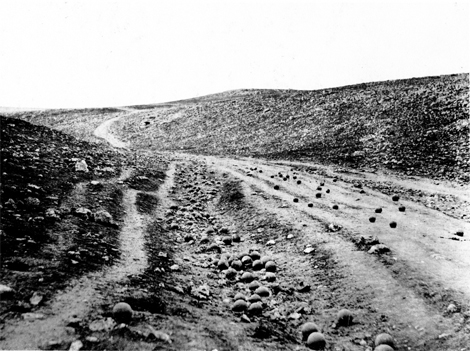
Okay. I was given a very stern warning here that I can’t go back. So you’ll have to just imagine what the previous photograph looked like. Notice the canon balls all over the road. They were taken from exactly the same camera position. And then Susan Sontag makes this very interesting claim that one of these photographs was clearly posed. Okay? And here is the nature of the claim. This photograph is the posed photograph. This is the photograph, by the way, that was more widely distributed than the other.
Let me see if I can simplify this to its essence. Fenton was a coward, a candy-ass. He wanted to make it look as though he was in much greater danger than, in fact, he was in, so he scattered these canon balls on the road to give the viewer the feeling of ongoing artillery fire. Okay? Well, I looked at these two photographs – God knows I looked at them again and again and again and again and again ad nauseam.
Balls off the road
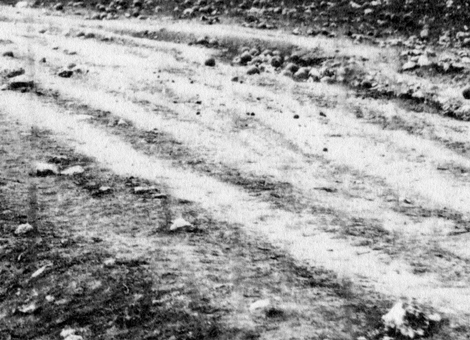
Balls on the road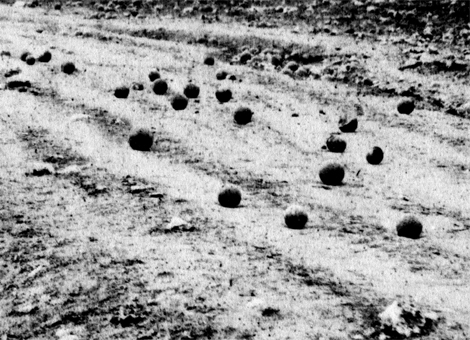
And I started to wonder, posed, posed in what way, to what end? Don’t these claims make reference to Fenton’s intentions, what he was thinking? Why he was taking the photographs? Stuff that was inside of Fenton’s head? It doesn’t necessarily show up on a photographic plate.
And then another question occurred to me. By the way, this is what led me to Abu Ghraib. So I am trying to answer this question; of course, of my own devising. But, trying to answer it. The question is: how do they know which was first and which was second? What tells you that they are to be ordered in that way?
And then I started to ask myself the question, are there independent ways in which I could try to ascertain this? Do we have to make assumptions about Fenton’s character? About what he was thinking? About his reasons for taking the pictures? Or is there another way of determining the order of the pictures. I became obsessed with a whole number of things and enlisted the help of a friend of mine, Dennis Purcell. He numbered the rocks and actually named quite a few of them. When some of the canon balls and rocks are personalized, it makes it more interesting. I, myself, became obsessed with the question of sun angle.
Sun Higher in Sky (balls on the road)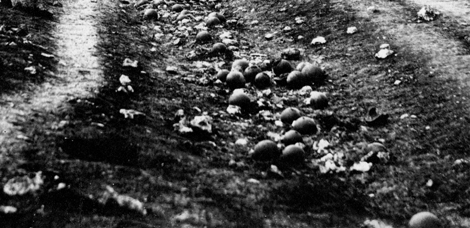
Sun Lower in Sky (balls off the road)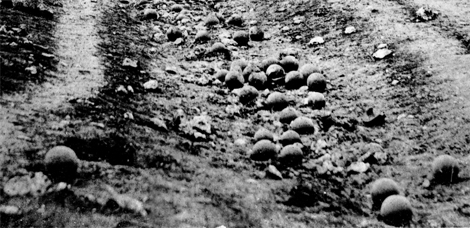
If you notice the shadow on these canon balls, the sun appears to be higher in the sky than in the second photograph which appears to be back lit. Could this be a clue? But wait a second, you still can’t know whether it’s in the morning or the afternoon from this information. And depending on whether it’s the morning or the afternoon, it reverses. If it’s the morning, the back lit would be first and the top lit second. If it’s the afternoon, it would be the other way around
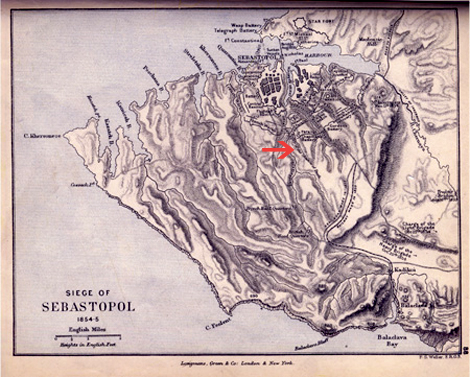
Let’s just go through this quickly. These are some maps that actually have the “The Valley of Death” written on them. My attempts to actually go through these various details, which I will not burden you with here. I believe time is running short. [laughter] They did include, though, my trip to the Crimean, to the “Valley of the Shadow of Death.” I tried very, very hard to convince my wife to come with me on this trip. And I thought my arguments were really, really compelling. I said, “This is not an opportunity to read the 23rd Psalm; this is an opportunity to experience the 23rd Psalm.” I thought: how can you turn down an opportunity like that? And I should mention that after I got there I found out that this place, the “Valley of the Shadow of Death” was for sale. [laughter] And that there was actually an opportunity, not just to simply read the 23rd Psalm and to experience the 23rd Psalm, but to actually own “The Valley of the Shadow of Death,” to own the 23rd Psalm. And then I had all these crazy ideas about timeshares. [laughter]
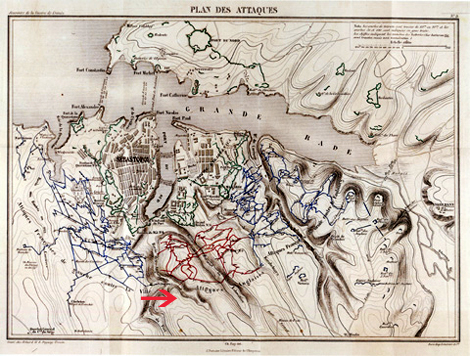
Here you can see I have film where the Xerox is being brought up and down over the landscape. Am I absolutely certain that I was in the right place? Well, I’m not absolutely certain about anything, including whether this makes any sense. But, I do believe I found the exact location.
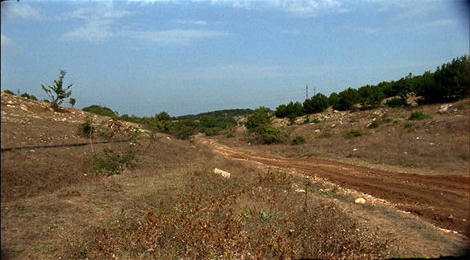
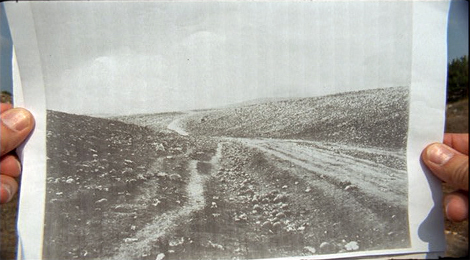
We tried to find a Russian guide to take us to the Valley of the Shadow of Death. But not one of the guides had any idea of what I was talking about. One thought that it was somewhere on the Worontzoff Road – a mistake that had been made in newspaper accounts in 1855. And it just so happened that I had picked the 150th anniversary of the fall Sebastopol in the Crimean War. And so there were guides and British tourists everywhere, most of them going to the site of the Charge of the Light Brigade. However, no one, I mean, no one was going to “The Valley of the Shadow of Death.” I was the only visitor. Well, my cameraman (Bob Chappell), myself, the first assistant cameraman (Eric Zimmerman), and the guide we eventually found (Olga Makarova).
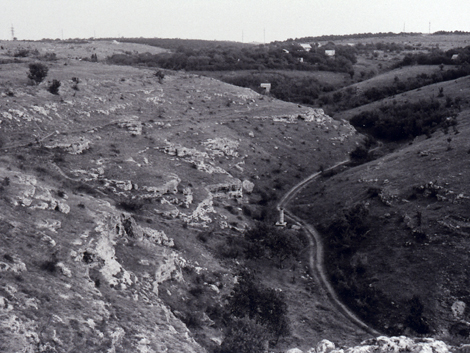
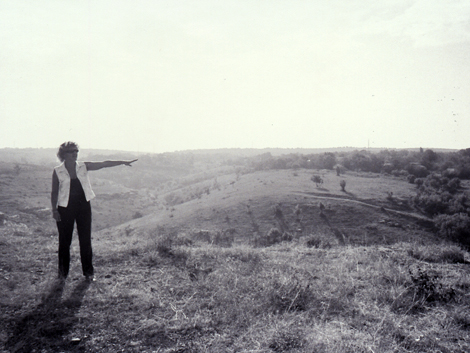
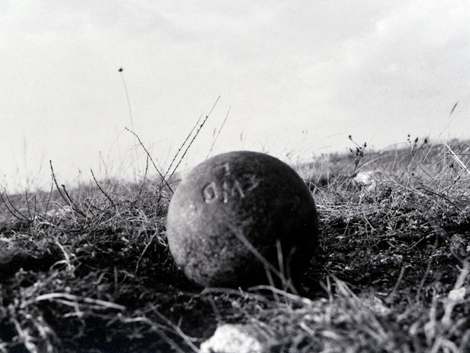
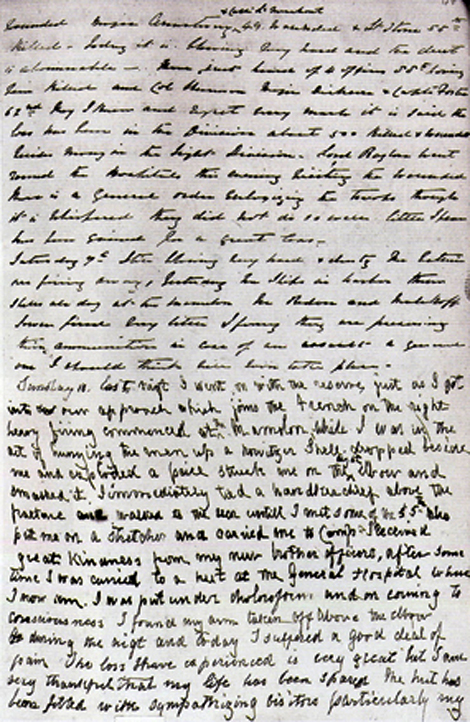
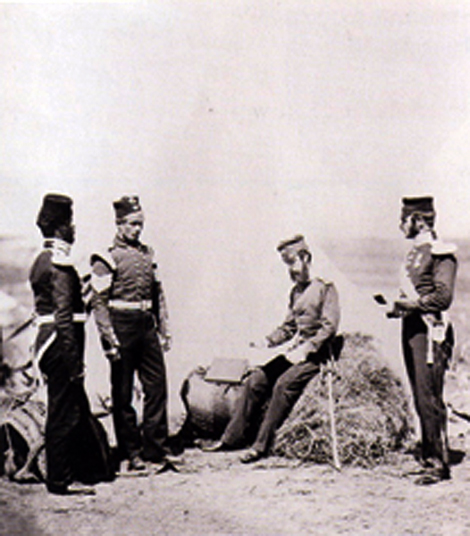
Notice how in the diary the handwriting changes. Okay? That’s fairly obvious. Actually, what’s so interesting about it is: the handwriting becomes much, much more clumsy, but at the same time much, much more readable. I don’t know what that tells us. Can you read what’s written on the left? “Last night I went on with the reserve… While I was in the act of hurrying the men up, a howitzer shell dropped besides me and exploded. It struck me on the right elbow and smashed it…”
His arm was blown off. Well, that’s interesting. Perhaps he was looking in the wrong direction. But he just kept writing in his diary – continuing on with his left arm. His right arm no longer being available. And the photograph became interesting to me because I had seen a date on it. And, of course, to date it, it was very important for me to figure out whether the arm was still attached or not. It’s a picture of the guy who wrote this material.
Let me just go quickly on. Here’s a point that I just wanted to make very, very briefly. And it’s something for you to think about. Whenever people ask me about films being true and false, I really have no idea what they’re talking about. I don’t. To me it’s like asking whether a book is true or false, or a newspaper is true or false. There are true things in them, false things in them. It’s a mixture. And our job is to figure out what is true and what is false.
In pictures the situation is different. Truth and falsity are linguistic. If you put a caption under a picture of the Titanic that says, “This is the Titanic,” you can say whether that caption is true or false. But the picture itself has no truth-value at all. It also occurred to me looking at those Fenton photographs that the whole issue of posing didn’t really make much sense to me.
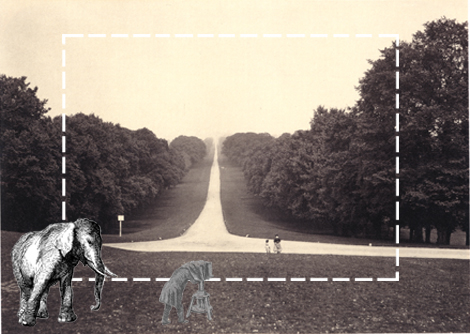
I constructed this image yesterday because I knew I had to give this lecture. Imagine that when anybody takes a photograph that they’re always excluding something by the very act of choosing a frame. You really don’t know what’s to the left or to the right of the frame, or what’s behind it. I guess behind the photographer, behind the emotion itself. You simply just do not know. And here’s my chain of reasoning, which I will do very quickly, and you can think about.
Say Susan Sontag was wrong about the order of those photographs. And it’s the photograph without the balls on the road, which is the second photograph. By her argument, it too would be posed, but it would be posed by the virtue of the fact Fenton removed stuff from the photograph. Are you with me? But, if something can be posed by virtue of the fact that something isn’t there, how could one ever figure that out by looking at the photographic plate itself? How can you see the absence of something? And the answer is that you cannot.
Although I composed this illustration for another very famous Fenton photograph, “A Long Walk, I could imagine that there was an elephant in the Valley of the Shadow of Death, and it kept walking back and forth in front of the camera. Fenton waited until the elephant had cleared the frame. Perhaps he had to say to his assistants, “Can you get the God damn elephant out of the frame? No, no, no, don’t take the picture quite yet. I don’t want the God damn elephant in the picture, as you well know.” [laughter]
It is really something to think about. And what it tells me, because I think that we should wrap this up in some way, if possible. What it tells me is that there is something really mysterious and really interesting about photographs. They give us information, but it’s not altogether clear what kind of information. And it becomes our job, to the extent possible, to figure out what they mean.
I am amazed, I guess this is self-congratulatory, but why not, I’m amazed that the photographs from Abu Ghraib were just looked at. They were taken as obvious or as self-evident even though they became political capital for all kinds of diverse people, with all kinds of diverse political axes to grind. They lent themselves to a variety of interpretations. They could become iconic photographs of soldiers that had simply gone awry. They could be photographs that reveal the various calumnies, the perfidies of this administration. I can’t quite say that I’m a stranger to those kinds of beliefs myself. To the Arab world they could be a symbol of the moral bankruptcy of the entire war, and a great excuse to continue a struggle with the West. They have meant many, many different things to many, many different groups of people.
And so it surprised me. With these two Fenton photographs, I talked to different historians of photography. I talked to about a dozen Fenton experts, and they disagreed about the order of the photograph. I’d say 40% thought that the photograph that had the balls off the road was second, and 60% believed it was the other way around. But, no one had actually – I’m returning to the self-congratulatory part – no one had actually tried to determine empirically from the photographs themselves what order they had been taken in.
Of course, with Fenton I did not have the opportunity to do talk with the photographer because Fenton is long dead. But, I do have that opportunity to talk to the people who took the photographs at Abu Ghraib. And to think about those photographs in a way very, very similar to the way that I have been thinking about Fenton’s photographs in the Crimea. The two are inextricably connected. But, basically I owe this current movie to Susan Sontag.
A close friend of mine, Ron Rosenbaum, said to me, “You mean you went all the way to the Crimea because of your irritation with one line in Susan Sontag?” I said, “Well, actually it was two lines.” And yes, I think that this movie, which I hope I can finish soon, actually is a genuine attempt to explore the mystery of those photographs, what they mean. What the people were thinking who took the photographs.
We all have a pretty good idea of how the photographs were used by the press and by the government. And how their infamy has affected so many, many, many things. But, there’s something very deep and very mysterious about all photographs, and those photographs in particular. And I’ve devoted myself to exploring that.
So is this my round about way of answering my own question of where my movies come from? I guess the answer is: how would I know? This is my most recent attempt. And it really came out of 19th century war photography. So I thought I would open this up to questions. I don’t know how much time we have left, but-- [applause] By the way, if any of you are interested in sun angle, I’d be willing to talk about that for a couple of hours quite happily.
Q: So basically Susan Sontag inspired you to use the Crimean War rather than Matthew Brady’s Civil War photographs, or World War I, etc.
A: A whole number of different factors. I’m interested in Civil War photographs. There’s a very famous Alexander Gardner photograph of the rebel sharpshooter at Gettysburg that is disputed and claimed to be a posed photograph. And yes, I am incredibly interested in that photograph as well. I thought I’d make a movie, and I’d have some of this Crimean material thrown in, and I’d have some Civil War material thrown in. And I would throw in a little Abu Ghraib. Well, it turns out you don’t throw in a little Abu Ghraib.
It’s that same problem I had when I was doing Fast, Cheap and Out of Control. I had done these five interviews. I had a topiary gardener, a lion tamer, a robot scientist and a photographer of naked mole rats. Plus, an execution machinery designer who happened to be, among other things, a Holocaust denier. And there was a question, am I going to put the Holocaust denier in Fast, Cheap? And my wife actually, as usual, explained this extraordinary well, saying that Hitler is not a spice. [laughter] Hitler is not a spice. You put Hitler in the soup and it becomes Hitler flavored.” [laughter] I think this is true.
So I had to make an entire movie about Fred Leuchter and his Holocaust denial, and his execution machinery. It was too big a topic for one movie. But, it was certainly too big a topic to be shoved in with all of those disparate elements in Fast, Cheap. It would have overwhelmed the movie and simply wrecked it. And I think the similar argument can be made for Abu Ghraib. No way really to do a movie about war photography where Abu Ghraib is just some incidental example. It’s not an incidental example; it’s one of the central stories of our time. And make no mistake; those photographs are among our most important and significant cultural icons.
Q: Why did you pick being a private detective among all of those possible job venues? And was photography involved?
A: Actually, photography was involved in a very, very curious way. I picked it because I was desperate. That’s usually the reason why I do most things. Yeah. I needed a job. And a friend of mine, who had been working for this extraordinary guy. He’s probably the best private detective in America.
He had gotten a job with Elizabeth Holtzman, who had just become DA in Brooklyn, and recommended me as his replacement. And this is at a time when there really was no detective agency. There was just Jim and myself working for Jim. Since then he started several companies that have become huge.
And it was fabulous because guess what? Being a private detective is not so different from what I do under ordinary circumstances. What I did was talk to people. Or, if you want to be more specific, I got people to talk to me. And that was essential.
But, the second part of the question, “Was photography involved?” And here’s how photography was involved. It’s really sad. There are a lot of terms you hear in the private detective business, which I’m very fond of. There’s “pretext,” there’s “heavy pretext.” I would distinguish between “pretext” and “heavy pretext,” pretext some of the things you say are lies, heavy pretext, everything you say is a lie.
But, I would identify myself as a filmmaker. Well, I’d made Gates of Heaven, and I’d made Vernon, Florida, so technically speaking I was a filmmaker, an unemployed, desperate filmmaker. But, if you believe Roger Ebert, a filmmaker. And I would identify myself as a filmmaker, and then people would talk to me. And there was this extraordinary thing. If you tell people you’re a filmmaker and you don’t have a camera with you, they think they can say anything. [laughter] Go figure.
But, I always felt crummy, because I would say, “I’m a filmmaker.” But then, of course, there would be this voice inside my head that would say, “You’re not a filmmaker. You’re not a filmmaker in this context. You’re doing something altogether different. And you know it.” And then another voice would say, “But, you really are a filmmaker. And those films were sort of good. And maybe you’ll make some again. And it’s not really a complete lie.” That’s how photography was involved. [applause]
Any other questions?
Q: Are there any films about you?
A: Yes. Kevin McDonald made a film about me, the guy who did The Last King of Scotland. And he used the Interrotron to interview me. You don’t know about the Interrotron. Sorry.
Briefly, it’s my interviewing machine. I developed, again named by my wife who liked the name. She said it had the word “interview” and the word “terror” in it. In fact, I used the Interrotron the very, very first time on Fred Leuchter. I’ve been something of a contrarian in every thing I’ve done.
Gates of Heaven, my first film, probably more so than any of the others, I set my sights on cinema verite. I was trying to violate every single rule of cinema verite that I could think of. This goes back to posing too, by the way. These issues are very, very much involved in the whole nature of documentary. But, that whole idea of being a fly-on-the-wall interested me not at all. It seemed to be, among other things, deeply disingenuous.
So I became fascinated with the whole question of eye contact, of that experience that we all have in everyday life of making eye contact with another person. We’re all aware of it. It’s wired into our brains probably by natural selection, if you believe in that sort of thing. But it is never preserved, never recorded in film interviews.
Just think about it for a moment. If somebody is being interviewed, you know you have the two people talking to each other, A and B or interviewer and interviewee, subject and interlocutor, however you want to describe it, they look at each other, they look into each other’s eyes. They make eye contact. That’s lost. We don’t record that on film because the camera is in some third place altogether. It’s observing two people talking.
And from my very, very first film, Gates of Heaven, I liked the idea of people looking into the lens of the camera. But I didn’t know really how to do it. So in my first film I would put my head right against the lens. And I would never, never use long lenses. I would always use wide-angle lenses, because the wider the angle, the more the appearance that the person is looking into the lens, and not slightly off camera.
If you know where to look in Gates of Heaven you can see the side of my head. My cameraman would grab my hair and yank me back while we were shooting. And I kept this up, film after film after film, wondering all the time, there must be a better way to do this. I had thought about the Interrotron for a good number of years. And I thought, oh no, no, no, you can’t do that. People are never going to tolerate that kind of thing. That’s so gimmicky, so weird. That’s stupid. But, maybe there’s nothing so stupid that it’s really all that stupid. Maybe.
Do you know about prompters, teleprompters? Prompters are set up so that a newscaster or politician can look directly into the lens of the camera and read text at the same time. And they do that by virtue of a half silvered mirror, and basically a television screen. So the television screen displays the text now inputted with a computer. And the politician or newscaster reads the text off of the mirror. And at the same time, since it’s a two way mirror since it’s half silvered, he’s being photographed. When his eyes focus on the text, he is looking directly into the lens of the camera. And so here was my idea, Errol’s excellent adventure, I got two prompters. I thought why are these used to actually display images of people, rather than just text?
So I had two cameras. I had a camera on me, the interviewer, and a camera on my subject, my interviewee, with two prompters, but I cross-connected the prompters. So that the image coming from the A camera goes to the B prompter, and the image coming from the B camera goes to the A prompter. So we’re both looking at each other’s live television images. And at the same time, looking directly down the lens of our respective cameras, the Interrotron. And I’ve now used it, I don’t know, hundreds and hundreds and hundreds of times.
I used it with Leuchter. I thought he would run screaming from the room. And he loved it. And my production designer, Ted Bafaloukos said, “Of course he loved it. It allows people to do what they do best. Watch TV.”
It’s interesting because over the years I used to have the saying, that “being there is the next best thing to using the phone.” There’s this idea that technology and human intimacy, whatever it might be, work against each other. I think that is actually untrue. Technology makes certain kinds of intimacy possible which would be otherwise unlikely to happen. The phone is one great example, because you say things on the phone that you probably wouldn’t say if someone were sitting right next to you. It would not unwind in that same way if you were in the same room. And yet phone conversations are quite intimate.
And the Interrotron has a remarkable way of encouraging people to speak. It’s also freed me. I always felt that I was chained to the camera. That I always had to have my head against the lens. And now, of course, I can be anywhere. That B camera and prompter could be on Mars. I don’t even really have to be on the same planet with the people that I’m interviewing anymore. And maybe I’m not.
Q: Although you don’t like cinema verite, you are nevertheless interested in truth. Are your films true?
A: Some sentences in them. Maybe. But I often think that what the public really wants, they don’t want the truth, they just want the appearance of truth. They want to be satisfied that something is true by having someone tell them it’s true – that it has some kind of USDA stamp on it, like a side of beef. And alas, truth doesn’t work that way. It’s a quest. It’s not something handed over with a stamp of approval.
Years ago when I first started making documentaries, I would rail against cinema verite. Just think of the term itself. There’s this not-so-hidden-truth claim built in. And I would think to myself, what is the idea here? Use available light. Hand hold the camera. Don’t touch anything. (Keep your hands to yourself.) Pretend not to be there. (Maybe crawl into some kind of foxhole.) Follow these rules faithfully, it’s like going to church or something. Follow these rules faithfully, and truth will emerge. All you have to do is behave yourself, follow the rules, and out pops truth.
And I thought about this for a long time, in a certain sense I’ve been thinking about it all my life. And I realized that style doesn’t guarantee truth. If someone told you that by changing the font of a newspaper you could make it more veridical, you would start laughing. Hopefully. The style in which you shoot a documentary does not make it more or less truthful. It has nothing whatsoever to do with whether what is being said is truthful or not.
Photography is no different. There is no truth in photography. There are claims made about photographs that one can say are true or false with respect to that photograph. But, a photograph itself has no truth-value whatsoever. Now, where do you draw the line?
You were mentioning those photographs that came out of the war in Lebanon. I believe that the AP photograph was censured because the photographer darkened the clouds of smoke in the sky. Darkened the clouds. Darkened them from what? Enhanced the image. Enhanced from what? Is there an Ur-image sitting somewhere on a shelf?
Q: Do you really believe that every image is posed?
A: Yes. Just for a moment return to my elephant just outside Fenton’s frame. I don’t think I can say very much more than that. One more question and I believe we have to stop. Who has the best question? [laughter]
Q: What do you think of Michael Moore’s documentaries?
A: What do I think of Michael Moore’s documentaries? They’re fine. [laughter] They’re classic agit-prop. I get a little miffed, and I know you want me to be a little miffed, so I will oblige. [laughter] I share an agent with Michael Moore, Ari Emanuel. His brother, of course, is the hero of the moment, Rahm Emmanuel.
When Fahrenheit 9/11 came out Ari said to me, “This is going to win the election for the Democrats.” And I said, “Uh, how silly of me, of course you’re right. Just like Bowling for Columbine caused the NRA to disband, and everyone in America turned in their handguns. What was I thinking?”
It’s an interesting phenomenon. Fahrenheit 9/11 became a religious movement – a secular religious movement – if that makes sense. It turned movie theaters into churches. People would go to the movies. They’d hold hands. They’d decry the Bush infidel together – the Bush devil. They’d cry on each others’ shoulders. When will we be delivered from bondage in Egypt? When will we be delivered to the Promised Land?
It was an extraordinary cultural phenomenon. How could one argue otherwise? Would I make them? No, I’m making this. [laughter] Thank you all very, very much.
END


